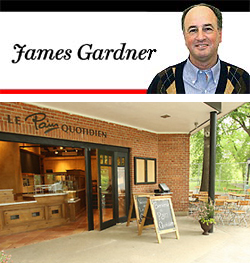Trending
Central Park’s Le Pain Quotidien ranks as one of the best things about New York City
 The Central Park Le Pain Quotidien
The Central Park Le Pain QuotidienProperly understood, the opening of Le Pain Quotidien, deep in the heart of Central Park, represents one of the most momentous changes to the park in half a century. This highly respected Belgian purveyor of fine breads, salads and soups now has 21 stores in the city, but none of them is as delightful as its newest, on the northern edge of Sheep Meadow.
The effect of the transformation surpasses every reasonable and even unreasonable expectation, since the new Pain Quotidien inhabits, without ostensibly changing, a drably mansarded structure in red brick, that has occupied this hill-top since 1957.
While a new Le Pain Quotidien is not an earth-shattering deal, it is to
me personally. Having grown up nearby on the Upper West Side, I have always known about this building and have witnessed its dreary changes through the decades. In all of those sundry incarnations, punctuated by periodic intervals of quiescence for years on end, this glorified concession stand seemed, despite new management, always to offer up the same watery hot chocolate, Cracker Jacks and greasy franks.
Once it had been far otherwise. For the structure you see today is really a replacement for a lovely Moorish pavilion designed by Jacob Wrey Mould in the 1860s. Known as the Mineral Springs Pavilion, it offered up a variety of salubrious waters to the thirsty citizenry. But with his habitual philistinism, Robert Moses, the once all-powerful parks commissioner, demolished Mould’s vision and in its place he erected the unprepossessing structure you see today. For more than half a century it presented itself to the world as nothing more than a narrow concession area looking east, its vague interior filled with storage space for the park department’s sundry fences and gardening paraphernalia.
The revelation of the new Pain Quotidien starts with the fact that it fully occupies and opens to the public the interior spaces of the pavilion, which turn out to be far vaster than one ever imagined. Like most of this brand’s interiors throughout the city, and indeed the world, the present space is adorned with pale woods in the French provincial style, a fully stocked bakery and a long, communal table, as well as individual tables.
But the still greater revelation is the two exterior spaces, one facing north, the other, more impressive still, facing east. From this latter vantage point, the entire park seems to be transformed. As you survey from on high Sheep Meadow to your right, another verdant slope to your left, and the Mall and Bandshell area straight ahead in the distance, the whole park seems to become far more elegant and orderly than you would ever have thought possible. And to see all of this while you enjoy a fine breakfast on a beautiful May morning is to realize that this new experience will soon take its place, if it hasn’t already, as one of the very best things about New York City.
James Gardner, formerly the architecture critic of the New York Sun, writes on the visual arts for several publications.




